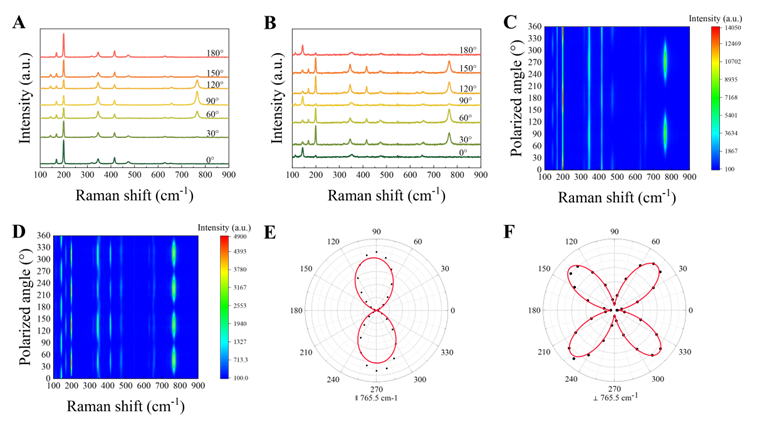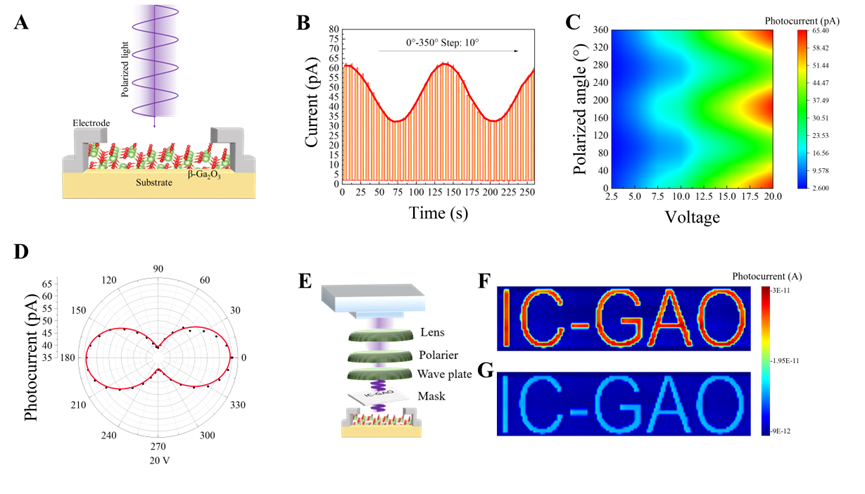
【Member Papers】Angle-resolved polarization Raman spectroscopy of β-Ga₂O₃ and their application in sensitive solar-blind photodetection
日期:2025-07-03阅读:227
Recently, researchers from Professor Tang Weihua's team from the School of College of Integrated Circuit Science and Engineering at Nanjing University of Posts and Telecommunications and Researcher Liu Zeng's team from the college at Inner Mongolia University conducted a systematic study on the optical anisotropy of β-Ga2O3 based on (100) planar β-Ga2O3 single crystal and successfully fabricated a solar-blind ultraviolet polarized photodetector. By studying the characteristics of polarized Raman and polarized light absorption, it was demonstrated that β-Ga2O3 has strong optical anisotropy. Based on its strong optical anisotropy, a solar-blind ultraviolet polarized photodetector was successfully fabricated. Under the irradiation of solar-blind ultraviolet polarized light at different angles, different photocurrents were generated. This has opened up a new way for the expansion of solar-blind ultraviolet polarized light detection.
Figure 1 shows the polarized Raman spectra in parallel and vertical modes, where the Raman intensity varies periodically at different polarization angles of 532 nm. The results indicate that β-Ga2O3 has strong optical anisotropy.

Figure 1 (a) Raman spectra of β-Ga2O3 at different polarization angles in the parallel polarization mode; (b) Raman spectra of β-Ga2O3 at different polarization angles in vertical polarization mode; (c) Raman spectra map in parallel mode; (d) Raman spectra map in vertical mode; (e) Raman polarization map of 765.5 cm-1 in parallel polarization mode; (f) Raman polarization map of 765.5 cm-1 in vertical polarized mode.
Figure 2 shows the light absorption characteristics of β-Ga2O3 at different polarization angles. The results indicate that the light absorption exhibits an intensity variation with π-periodicity, and the light absorption intensity variation only occurs at 240 nm.
 Figure 2 (a) Light absorption in the 240 to 400 nm band at different polarization angles; (b) Contour map of light absorption at different polarization angles; (c) Polarization map of solar-blind ultraviolet absorption at a wavelength of 240 nm; (d) Polarization map of solar-blind ultraviolet light at 255 nm wavelength; (e) Polarization map of solar-blind ultraviolet light absorption at a wavelength of 270 nm.
Figure 2 (a) Light absorption in the 240 to 400 nm band at different polarization angles; (b) Contour map of light absorption at different polarization angles; (c) Polarization map of solar-blind ultraviolet absorption at a wavelength of 240 nm; (d) Polarization map of solar-blind ultraviolet light at 255 nm wavelength; (e) Polarization map of solar-blind ultraviolet light absorption at a wavelength of 270 nm.
Figure 3 shows the prepared solar-blind ultraviolet polarization detector and the dynamic curve of the solar-blind ultraviolet polarization detection. The results demonstrate excellent polarization sensitivity characteristics. Finally, Raman polarization imaging was performed on the device, and the results showed that the device had good polarization imaging capability.
 Figure 3 (a) Schematic diagram of the polarized photodetector; (b) Transient light response characteristics under polarized light from 0 to 350°; (c) Photocurrent contour maps of light at different polarization angles; (d) Photocurrent polarization map at 20 V; (e) Schematic diagram of the polarization imaging sensor measurement system; (f) Imaging results at 0°; (g) Imaging results at 90°.
Figure 3 (a) Schematic diagram of the polarized photodetector; (b) Transient light response characteristics under polarized light from 0 to 350°; (c) Photocurrent contour maps of light at different polarization angles; (d) Photocurrent polarization map at 20 V; (e) Schematic diagram of the polarization imaging sensor measurement system; (f) Imaging results at 0°; (g) Imaging results at 90°.
The first author of the paper is Lei Li, a doctoral student at Nanjing University of Posts and Telecommunications. The corresponding authors are Professor Weihua Tang from Nanjing University of Posts and Telecommunications, Associate Professor Lingfeng Gao from Hangzhou Normal University, and Researcher Zeng Liu from Inner Mongolia University. The main participants in this work also include Researcher Zhang Jiahan from Inner Mongolia University, Researcher Jiang Mingming from Nanjing University of Aeronautics and Astronautics, and Dr. Zhang Shaohui from the Guangdong Academy of Sciences.
Team Introduction
Tang Weihua is a professor and doctoral supervisor at the College of Integrated Circuit Science and Engineering also known as the College for Industry-Education Integration) of Nanjing University of Posts and Telecommunications. He received his Ph.D. from the Institute of Physics, Chinese Academy of Sciences in 1994. He has presided over more than twenty major and key national and provincial-level projects, including projects under the National Key Research and Development Program of China, projects funded by the National Natural Science Foundation of China, special projects of the Beijing Science and Technology Plan, and Jiangsu Provincial Entrepreneurship and Innovation Team projects. More than 400 SCI-indexed papers have been published in important academic journals at home and abroad, with over 17,000 citations. He enjoys the special government allowance from The State Council, has been selected for the "New Century Hundred, Thousand and Ten Thousand Talents Project" of the country, the "Hundred Talents Program" of the Chinese Academy of Sciences, the "Entrepreneurship and Innovation Talent" of Jiangsu Province, the leading talent of the "Entrepreneurship and Innovation Team" of Jiangsu Province, and has won the first and second prizes of the Beijing Science and Technology Award.
Liu Zeng, a researcher and master's supervisor at the college of Electronic and Information Engineering, Inner Mongolia University, mainly focuses on the research of wide band gap semiconductor optoelectronic devices and physics. He received his Ph.D. from Beijing University of Posts and Telecommunications in 2021. He was selected for Inner Mongolia Autonomous Region's "Talents for Inner Mongolia" High-level Talent program and Inner Mongolia University's "Horse Program" High-level Talent Introduction Program. He formerly served as an Associate Professor (Presidentially Appointed) and master's Supervisor at Nanjing University of Posts and Telecommunications. He has served as a young editorial board member of Exploration and guest editor of Crystals. He was consecutively selected for World's Top 2% Scientists in 2023 and 2024. Principal Investigator of projects funded by the National Natural Science Foundation of China and key laboratories of the Ministry of Industry and Information Technology. Adv. Mater., Laser Photonics Rev., Adv. Opt. Mater., Appl. Phys. Lett., IEEE Electron Device Lett. More than 50 papers have been published in journals such as Cell Reports Phys. Sci., Opt. Lett., and ACS Photonics.
Article Information
Angle-resolved polarization Raman spectroscopy of β-Ga2O3 and their application in sensitive solar-blind photodetection
Lei Li; Sihan Yan; Wanyu Ma; Jia-Han Zhang; Shaohui Zhang; Mingming Jiang; Lingfeng Gao; Weihua Tang; Zeng Liu
Appl. Phys. Lett. 125, 141102 (2024)
https://doi.org/10.1063/5.0223518


